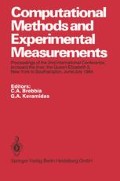Abstract
A large range of continuum mechanics problems can nowadays be solved using boundary rather than domain solutions. In particular, the Boundary Element Method has been applied to analyse many fluid mechanics and stress analysis problems [1], [2]. The advantages of the technique versus classical domain solutions such as finite differences or finite elements have been discussed in many published references but can be summarised as follows:-
-
(i)
The method requires only the discretisation of the surface of the body into a series of elements similar to the well known finite element method but with one degree less of dimensionality. This characteristic not only reduces the number of unknowns but more important, considerably simplifies the amount of data required to run a problem.
-
(ii)
By using influence solutions which are valid at infinity, the solution of unbound problems does not require any special treatment. This implies that a large number of cases where the domain under consideration extends to infinity can be solved without resource to large meshes and artificial body conditions.
-
(iii)
The standard approach used in boundary elements is a mixed type of formulation which ensures that different variables in a problem (such as fluxes and temperatures, stresses and displacements, etc) are found with the same degree of accuracy. This extra accuracy makes the method well suited to problems such as stress concentration and those with high temperature gradient regions, etc.
-
(iv)
Contrary to domain techniques, boundary element analysis codes are easy to interface with standard CAD systems as they do not require complex pre and post processing facilities. The surface meshes needed to run a programme are easy to generate and the post processing can be done ‘a posteriori’, ie once the boundary solution is found the designer can request the internal points on a particular plane or line.
Access this chapter
Tax calculation will be finalised at checkout
Purchases are for personal use only
Preview
Unable to display preview. Download preview PDF.
References
Brebbia, C.A. The Boundary Element Method for Engineers, Pentech Press, London and Halstead Press, New York, 1978.
Brebbia, C.A., J. Telles and L. Wrobel, Boundary Element Techniques - Theory and Applications in Engineering, Springer-Verlag, Berlin and New York, 1984.
Reisser, E. “A Note on Variational Principles in Elasticity”, International Journal of Solid Structures, I, pp. 93–95, 1965.
Pian, T.H.H. and P. Tong, “Basis of Finite Element Method for Solid Continua”, International Journal of Numerical Methods in Engineering, 1, pp. 3–28, 1969.
Washizu, K. Variational Methods in Elasticity and Plasticity, 2nd Edition, Pergamon, New York, 1975.
Cruse, T.A. and F.J. Rizzo, “A Direct Formulation and Numerical Solution of the General Transient Elasto-dynamic
Problem“, Int. J. Meth. Appl., 22, pp.244–259, 1968.
Brebbia, C.A. (Ed.) “Recent Advances in Boundary Element Methods”, 1st International Conference on Boundary Element Methods, Southampton University, 1978, Pentech Press, 1978.
Brebbia, C.A. (Ed.) “New Developments in Boundary Element Methods”, Proceedings of 2nd International Conference on Boundary Element Methods, Southampton University 1980, CMi. Publications, Southampton, 1980.
Brebbia, C.A. (Ed.) “Boundary Element Methods”, Proceedings of the 3rd International Conference on Boundary Element Methods, Irvine, California, 1981, Springer-Verlag, Berlin and New York, 1981.
Brebbia, C.A. (Ed.) “Boundary Element Methods in Engineering”, Proceedings of the 4th International Conference on Boundary Element Methods, Southampton University, 1982, Springer-Verlag, Berlin and New York, 1982.
Brebbia, C.A., T. Futagami and M. Tanaka, “Boundary Elements”, Proceedings of the 5th International Conference on Boundary Element Methods, Hiroshima Institute of Technology, 1983, Springer-Verlag, Berlin and New York, 1983.
Brebbia, C.A. and D. Nardini, “Dynamic Analysis of Solid Mechanics by an Alternative Boundary Element Procedure”, Int. Journal of Soil Dynamics and Earthquake Engineering, Vol. 2, No. 4, pp. 228–233.
Nardini, D. and C.A. Brebbia, “A New Approach to Free Vibration Analysis using Boundary Elements” in Boundary Element Methods in Engineering ( C.A. Brebbia, Ed.), Springer-Verlag, Berlin and New York, 1982.
Wrobel, L.C. and C.A. Brebbia, “Boundary Elements in Thermal Problems”, Chapter 5 in Numerical Methods in Heat Transfer, (Eds. R.W. Lewis, K. Morgan and O.C. Zienkiewicz) Wiley, London, 1981.
Wilson, E.L. and R.E. Nickell, “Applications of the Finite Element Method to Heat Condition Analyses”, Nucl. Engineering Design, 4, pp. 276–286, 1966.
Peavy, B.A. “Steady-State Heat Conduction in an Exposed Exterior Column of Rectangular Cross Section”, J. Res. Math. Bur. Stand., 696, pp. 145–151, 1965.
Telles, J.C.F. and C.A. Brebbia, “Boundary Element Solutions for Half-Plane Problems”, Int. J. Solids and Structures, Vo1. 17, No. 12, pp. 1149–1158, 1981.
Melan, E. “Der Spannungszustand Der Durch Eine Einzelkraft In Innern Beanspruchten Halbscheibe”, Z. Angew. Math. Mech., 12, 343–346, 1932.
Jeffrey, G.B. “Plane Stress and Plane Strain in Bipolar Coordinates”, Trans. R. Soc. (London), see A, 221, pp. 265–293, 1920.
Mindlin, R.D. “Stress Distribution around a Hole near the Edge of a Plate under Tension”, Proc. Soc. Exptl. Stress. Anal. 5, pp. 56–58, 1948.
Author information
Authors and Affiliations
Editor information
Editors and Affiliations
Rights and permissions
Copyright information
© 1984 Springer-Verlag Berlin Heidelberg
About this paper
Cite this paper
Brebbia, C.A. (1984). The Solution of Continuum Mechanics Problems Using Boundary Elements. In: Brebbia, C.A., Keramidas, G.A. (eds) Computational Methods and Experimental Measurements. Springer, Berlin, Heidelberg. https://doi.org/10.1007/978-3-662-06375-0_22
Download citation
DOI: https://doi.org/10.1007/978-3-662-06375-0_22
Publisher Name: Springer, Berlin, Heidelberg
Print ISBN: 978-3-662-06377-4
Online ISBN: 978-3-662-06375-0
eBook Packages: Springer Book Archive

